I first met Andrea Wady after leaving Christmas day to fly to Costa Rica, taking a four hour bus ride to her town, staying in a local hostel for a few days to do some reflective writing, and then being picked up by her husband Chris for a bumpy ride down the dirt roads to where they kept their horses.
My suspicion was confirmed right away – Andrea and I were kindred souls. Over the next few days I learned so much from Andrea about relationship building with horses, spending peaceful hours out in the fields with her herd.
Fast forward to now, and Andrea and I have spent many more hours together with horses, as I traveled to her clinic in Virginia, to see her again in Costa Rica, and she came to my farm in Pennsylvania to film the Pure Liberty Course.
We are preparing to present Andrea’s second course, Pure Connection for Kids, but wanted to first share the following article from Andrea on The Art of Leading.
Liberty has always been my passion and led me to launching the Pure Liberty course with Callie here at HorseClass, but there is so much we can do, with a liberty mindset, using our tools such as the halter and lead rope.
As a teacher and equine behaviorist, I help humans and horses get along better.
I think of myself like a relationship coach who can help translate the differences between us humans and our beloved horses so we can all get along better.
Leading is a prime example of an exercise that can help us either deeply bond with our horses or fracture our friendship.
I’d like to share 5 tips to help you connect with your horse, relax, and have fun in the process.
As horse owners, we tend to fall into one of two categories, the hurry up and rush type, or the follow and let your horse do as they please type. As always, I find the middle ground to be the place where harmony is found.
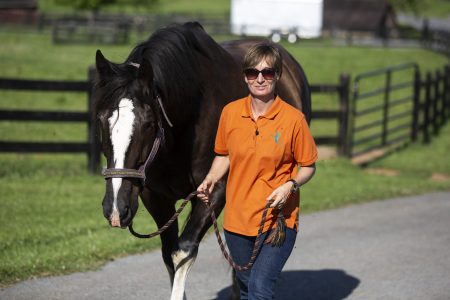
Here are 5 Keys to Bring Art into Your Leading:
1 Keep a smile in the lead rope as often as you can.
Most people tend to hold their horses close and tight – for me this just portrays the fact that we don’t trust the horse and they in turn cannot trust us.
When you are leading and all is going nicely, make sure that you have a line loose enough that the horse can easily move their head from side to side and feel no resistance from you.
If they are constantly feeling pressure, it teaches them to brace. They also will not understand when the pressure means something and when it doesn’t.
Of course, make sure the rope is not so looped that your horse can stand on it or that you cannot be effective if needed.
I like to lead with a smile in the rope and an open hand which can close if needed to support my decision about our speed and direction.
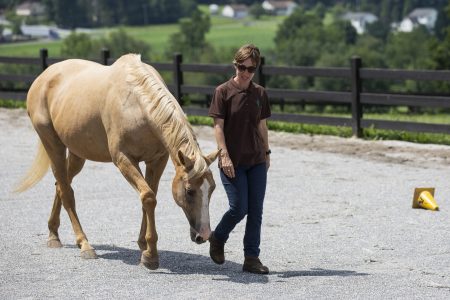
2 Match your horse’s feet when you walk.
This lets them feel you are in harmony with them, and walking with an easy, rhythmic gait will encourage your horse to do the same.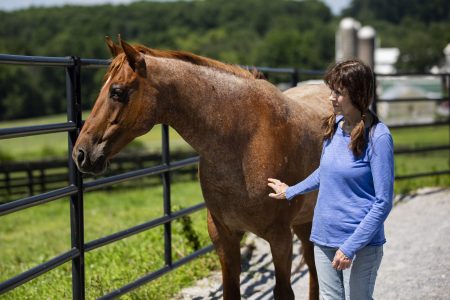
3 Look all around you!
Humans have their eyes on the front of their head and horses on the side, look at the view they are seeing by moving your head from side to side and take in all the environment around you.
This helps us to be less single focused, and being single focused is a sure-fire way to have your horse disconnect from you.
When you look around, your horse can also trust that you are looking out for them.
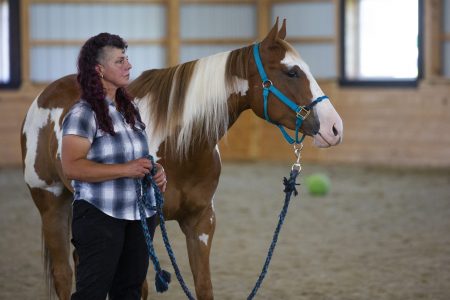
4 When you stop trust they will stop with you but correct if they don’t.
When a horse is in sync with you, stopping is as easy as exhaling and your horse will stop with you. It really can be this easy!
However, many horses have learned to lean on the tension we put in the rope.
Think about this from the horse’s point of view. If you lead your horse with constant pressure on the rope, they learn to tune it out and then we have to pull harder and harder to be noticed.
Be effective and clear. When you want to stop, prepare, let the horse know what is coming, take an audible breath out, sink down into your body and stop walking.
if the horse doesn’t stop, then ask with your rope. Don’t use the rope first, give your horse the chance to move with you while keeping that smile in your rope!
You may find after a few goes you won’t need the rope at all!
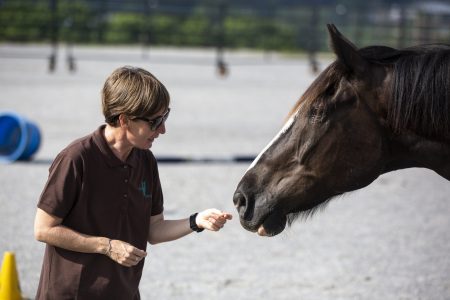
5 Be someone that your horse wants to stay beside.
This is not as hard as it sounds. Be interested in what they are interested in, touch what they touch, sniff what they sniff (ok maybe not the poop piles), look where they look.
The liberty mindset is something you can use when you are leading your horse, by acting as if you don’t have the rope.
Given tools, most of us will use them far too much on our horses.
The number of times I see new students experience a beautiful liberty session, only to follow it by being dragged around by their horse when the halter goes back on or having to force the horse to follow them.
It always amazes me how when I take the halter and lead away, horse and person have a beautiful connection, but give it back and we resort to a tug of war.
Often this is just built through years of unconscious brace.
Act as if you are at liberty and the harmony that can follow can set up your partnership for an incredible future together.
Instead of relying on the rope when I am leading, I try to ask my horse to turn by gently pushing on their neck, or asking them to follow by offering the back of my hand as I move forward.
Remember when they follow my hand, I will then let them touch it and have some time to do what they like. This builds trust and a mutual partnership.
Pay attention, if you see something your horse is likely to stop and look at, be the first one to stop, don’t just drag them on forward.
If your horse feels like you are seeing what they are, you will build your friendship much more than ploughing on and ignoring it.
Stand with your horse, take a few breaths, look all around and then carry on, asking with just your hand to follow, or the rope gently if needed.
Leading is an art form… through leading, you can make or break your relationship with your horse.
These five tips will help you on your way to a better friendship.
Building trust with a liberty mindset, with or without tools, is the best way in my opinion to create an incredible connection and friendship with your horse. At that point, tools are only needed for safety.
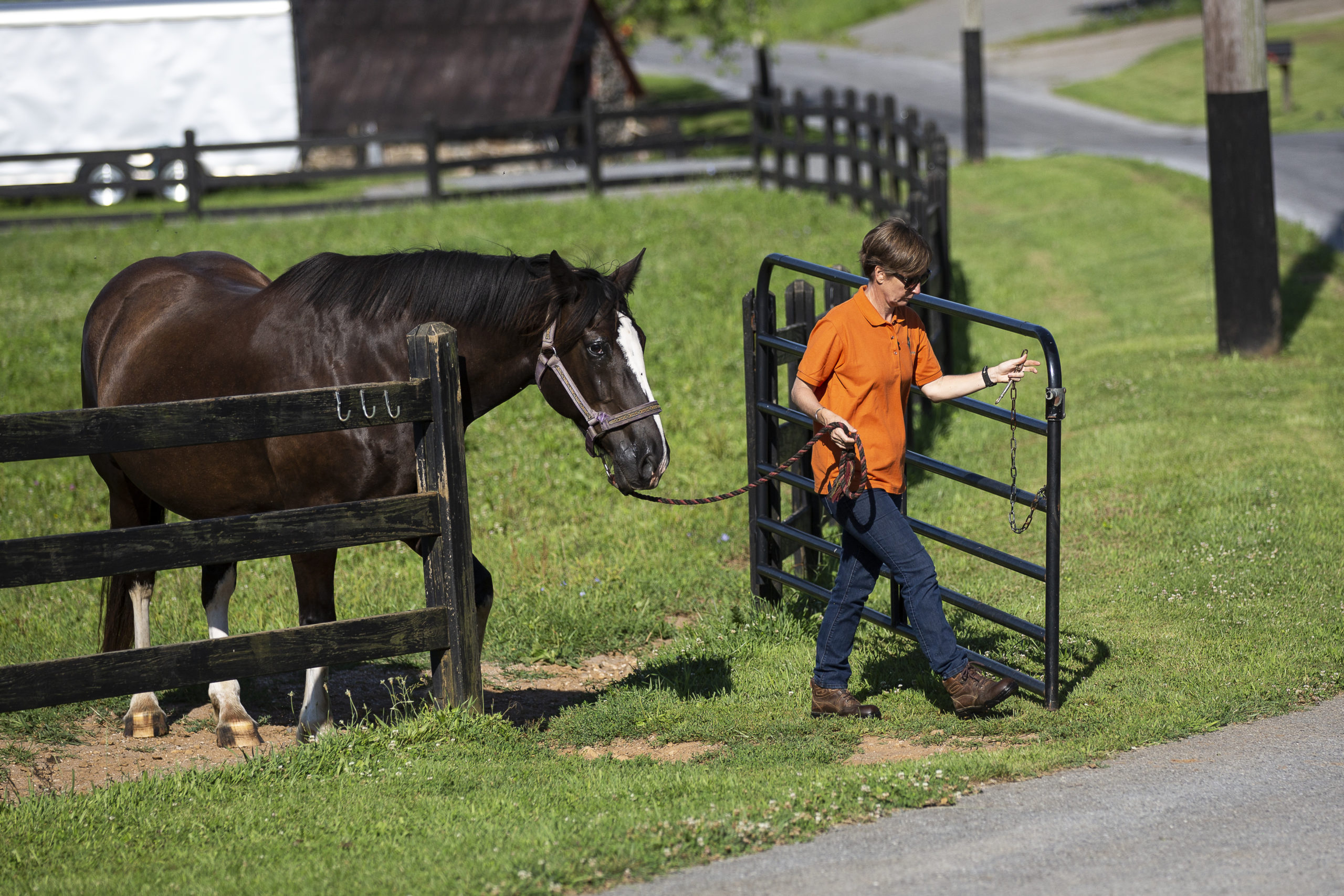
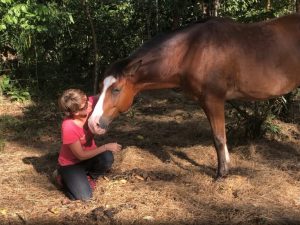
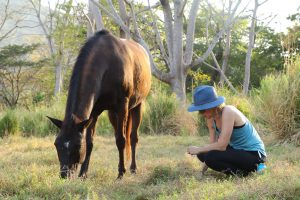











2 Responses
Oooh! It was so fun to see a picture of my daughter, Carrie, with this article. We enjoyed the liberty work in Costa Rica.
That photo was one of my favorites from the trip Dorothy!
-Julia, HorseClass Community Manager